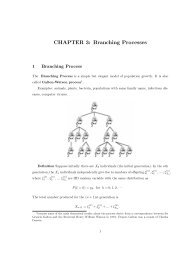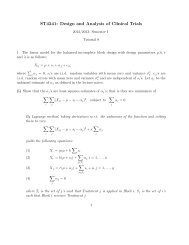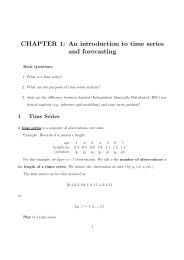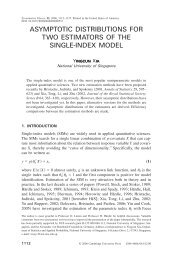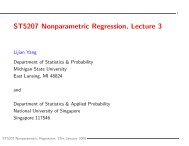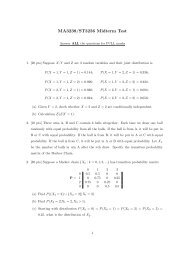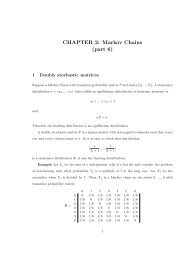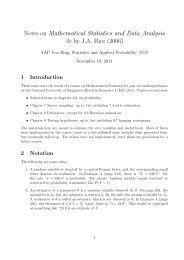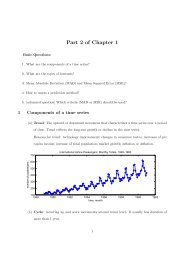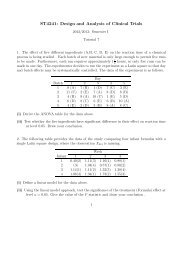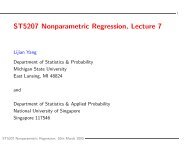ST3242: Introduction to Survival Analysis - The Department of ...
ST3242: Introduction to Survival Analysis - The Department of ...
ST3242: Introduction to Survival Analysis - The Department of ...
You also want an ePaper? Increase the reach of your titles
YUMPU automatically turns print PDFs into web optimized ePapers that Google loves.
<strong>ST3242</strong>: <strong>Introduction</strong> <strong>to</strong> <strong>Survival</strong> <strong>Analysis</strong><br />
(2006-2007 Semester I)<br />
Schedule:<br />
Time: Mondays & Thursdays 10:00 am - 12:00 noon<br />
Venue: S13-05-05<br />
Final Exam: <strong>to</strong> be announced later<br />
Course Objective:<br />
To introduce the students <strong>to</strong> the basic statistical methodology for<br />
analyzing survival data<br />
To equip the students with the basic <strong>to</strong>ols for survival data analysis<br />
To nurture general statistical thinking<br />
Major Reference:<br />
David W. Hosmer, Jr and Stanley Lemeshow<br />
Applied <strong>Survival</strong> <strong>Analysis</strong>: Regression<br />
Modeling <strong>of</strong> Time <strong>to</strong> Event Data<br />
1999, John Wiley & Sons, Inc<br />
Minor Reference<br />
J.P. Klein and M. L. Moeschberger<br />
<strong>Survival</strong> <strong>Analysis</strong>: Techniques for censored<br />
and truncated data.<br />
2nd ed. 2003, Springer<br />
<strong>The</strong> <strong>to</strong>pics covered will be within the scope <strong>of</strong> the major reference. Some<br />
course materials will be taken from the minor reference.<br />
Assessment:<br />
Tu<strong>to</strong>rial 10%,<br />
Middle term exam 30%,<br />
Final exam 60%
Course Outline<br />
1. <strong>The</strong> basics <strong>of</strong> survival analysis<br />
• Special features <strong>of</strong> survival analysis<br />
• Censoring mechanisms<br />
• Basic functions and quantities in survival analysis<br />
• Models for survival analysis<br />
2. Descriptive methods and univariate analysis<br />
• Kaplan-Meier estima<strong>to</strong>r <strong>of</strong> survival function<br />
• Confidence bands for the survival function<br />
• Point and interval estimates <strong>of</strong> quantiles <strong>of</strong> survival time<br />
• Point and interval estimates <strong>of</strong> the mean survival time<br />
• Estimation <strong>of</strong> other functions <strong>of</strong> survival time<br />
• Comparison <strong>of</strong> survival curves<br />
3. Regression models for survival data<br />
• Coding covariates<br />
• Semi-parametric regression models<br />
• Proportional hazards regression model with distinct-event time<br />
data<br />
• Proportional hazards regression model when ties are present<br />
• Estimation <strong>of</strong> the survival function <strong>of</strong> the regression model
4. Interpretation <strong>of</strong> proportional hazards regression models<br />
• Nominal and continuous scale covariates<br />
• Multiple covariate models<br />
• Covariate adjusted survival functions<br />
5. Model building and diagnostics<br />
• Variable selection techniques<br />
• Residuals<br />
• Assessing the proportional hazards assumption<br />
• Checking the influence <strong>of</strong> individual observations<br />
• Overall goodness-<strong>of</strong>-fit measures<br />
• Interpretation <strong>of</strong> the final model<br />
6. Other <strong>to</strong>pics<br />
• Extension <strong>of</strong> the proportional hazards model<br />
• Parametric models



